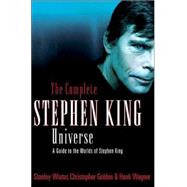
Note: Supplemental materials are not guaranteed with Rental or Used book purchases.
Purchase Benefits
What is included with this book?
| Acknowledgments | xiii | ||||
| Introduction: The Worlds of Stephen King | xv | ||||
| Stephen King: A Chronology | xxiii | ||||
| SECTION ONE THE WORLDS OF THE DARK TOWER AND THE STAND | |||||
|
9 | (6) | |||
|
15 | (7) | |||
|
22 | (7) | |||
|
29 | (7) | |||
|
36 | (7) | |||
|
43 | (6) | |||
|
49 | (9) | |||
|
58 | (5) | |||
|
63 | (6) | |||
|
69 | (5) | |||
|
74 | (10) | |||
|
84 | (9) | |||
|
93 | (12) | |||
|
93 | (1) | |||
|
93 | (2) | |||
|
95 | (10) | |||
| SECTION TWO THE PRIME REALITY | |||||
|
|||||
|
105 | (9) | |||
|
114 | (8) | |||
|
122 | (9) | |||
|
131 | (8) | |||
|
139 | (8) | |||
|
139 | (1) | |||
|
140 | (7) | |||
| SECTION THREE THE PRIME REALITY | |||||
|
|||||
|
147 | (6) | |||
|
153 | (7) | |||
|
160 | (5) | |||
|
165 | (8) | |||
|
173 | (20) | |||
|
173 | (4) | |||
|
177 | (1) | |||
|
177 | (1) | |||
|
178 | (1) | |||
|
178 | (2) | |||
|
180 | (2) | |||
|
182 | (11) | |||
| SECTION FOUR THE PRIME REALITY | |||||
|
|||||
|
193 | (7) | |||
|
200 | (10) | |||
|
210 | (6) | |||
|
216 | (4) | |||
|
220 | (4) | |||
|
224 | (6) | |||
|
230 | (7) | |||
|
237 | (5) | |||
|
242 | (6) | |||
|
248 | (18) | |||
|
248 | (1) | |||
|
249 | (1) | |||
|
250 | (1) | |||
|
251 | (3) | |||
|
254 | (1) | |||
|
255 | (1) | |||
|
255 | (2) | |||
|
257 | (1) | |||
|
258 | (1) | |||
|
259 | (1) | |||
|
260 | (1) | |||
|
260 | (6) | |||
| SECTION FIVE THE PRIME REALITY | |||||
|
|||||
|
266 | (8) | |||
|
274 | (7) | |||
|
281 | (5) | |||
|
286 | (178) | |||
|
286 | ||||
| SECTION SIX OTHER PRIME REALITY TALES | |||||
|
299 | (7) | |||
|
306 | (11) | |||
|
317 | (7) | |||
|
324 | (8) | |||
|
332 | (8) | |||
|
340 | (9) | |||
|
349 | (5) | |||
|
354 | (7) | |||
|
361 | (4) | |||
|
365 | (5) | |||
|
370 | (10) | |||
|
380 | (6) | |||
|
386 | (8) | |||
|
394 | (2) | |||
|
396 | (6) | |||
|
402 | (5) | |||
|
407 | (13) | |||
| SECTION SEVEN THE WORLD OF RICHARD BACHMAN | |||||
|
420 | (5) | |||
|
425 | (6) | |||
|
431 | (5) | |||
|
436 | (6) | |||
|
442 | (6) | |||
|
448 | (7) | |||
|
455 | (9) | |||
|
464 | (11) | |||
|
464 | (1) | |||
|
465 | (1) | |||
|
466 | (1) | |||
|
466 | (1) | |||
|
467 | (1) | |||
|
468 | (1) | |||
|
468 | (2) | |||
|
470 | (1) | |||
|
471 | (4) | |||
| SECTION EIGHT TALES FROM BEYOND: FURTHER PARALLEL REALITIES | |||||
|
475 | (8) | |||
|
476 | (1) | |||
|
476 | (1) | |||
|
477 | (2) | |||
|
479 | (1) | |||
|
480 | (1) | |||
|
480 | (1) | |||
|
481 | (2) | |||
| Appendix A: Recommended Further Reading | 483 | (6) | |||
| Appendix B: Recommended Web Sites | 489 | (4) | |||
| Appendix C: The Fiction of Stephen King, in Order of Publication | 493 | (2) | |||
| Index | 495 |
The New copy of this book will include any supplemental materials advertised. Please check the title of the book to determine if it should include any access cards, study guides, lab manuals, CDs, etc.
The Used, Rental and eBook copies of this book are not guaranteed to include any supplemental materials. Typically, only the book itself is included. This is true even if the title states it includes any access cards, study guides, lab manuals, CDs, etc.
Excerpted from The Complete Stephen King Universe: A Guide to the Worlds of Stephen King by Stanley Wiater, Christopher Golden, Hank Wagner
All rights reserved by the original copyright owners. Excerpts are provided for display purposes only and may not be reproduced, reprinted or distributed without the written permission of the publisher.